A Qualitative Study: Analyzing Social Media and Relationships
VerifiedAdded on 2023/04/11
|13
|3236
|235
Case Study
AI Summary
This case study presents a qualitative analysis of social media's influence on relationships, drawing from interview data analyzed through a positivism philosophy and deductive approach. The study explores various themes, including the importance of social media in users' lives, its role in communication and relationship building, and the perceived securities and insecurities within virtual interactions. It also compares virtual and physical relationships, examines the motivations behind social media use, and discusses the concept of social media as a form of identity. The findings reveal that while social media facilitates communication and provides a platform for building relationships, it also presents risks such as identity theft and the potential for misleading interactions. The study highlights the balance between the benefits and drawbacks of social media in the context of modern social dynamics.
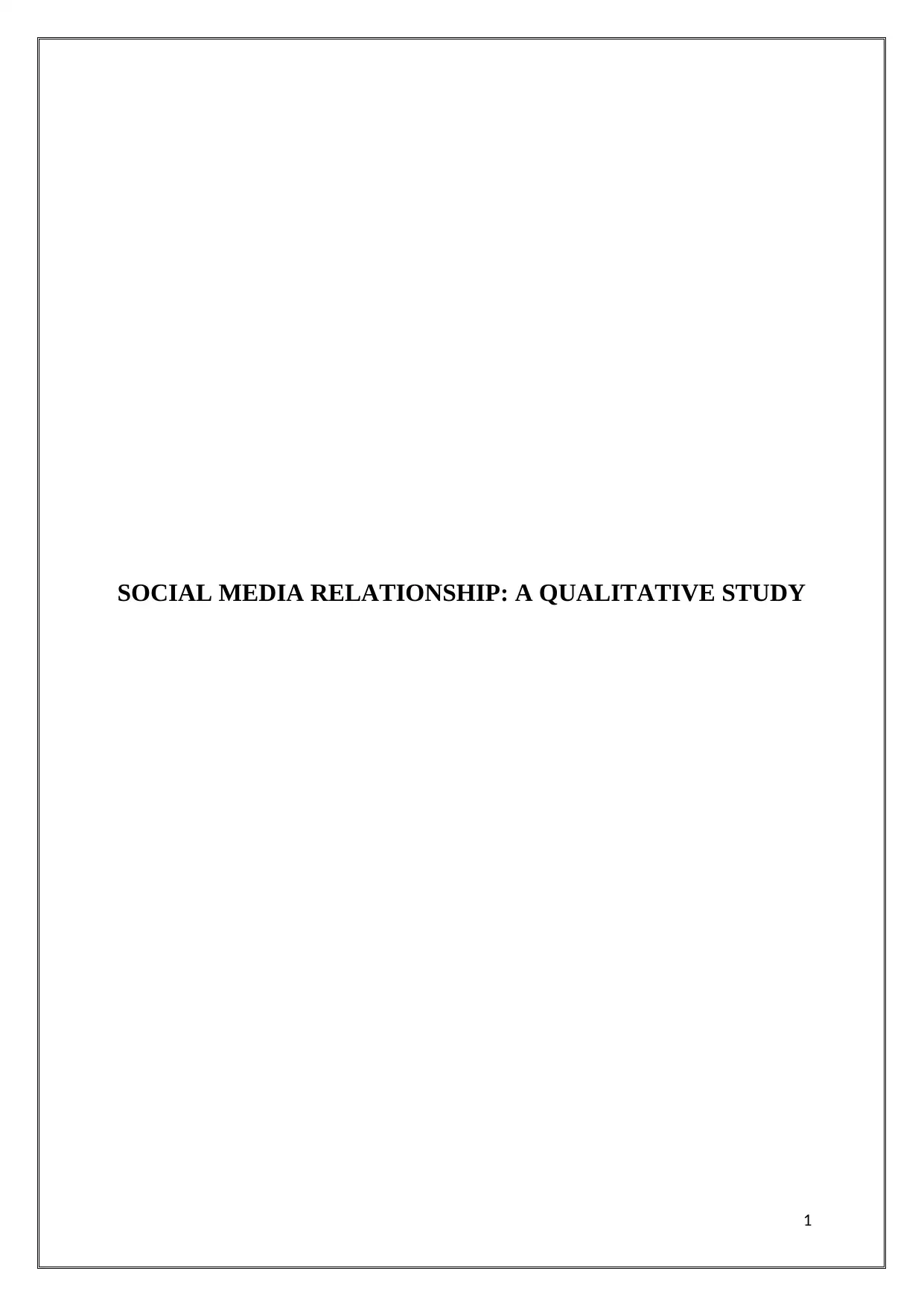
SOCIAL MEDIA RELATIONSHIP: A QUALITATIVE STUDY
1
1
Paraphrase This Document
Need a fresh take? Get an instant paraphrase of this document with our AI Paraphraser
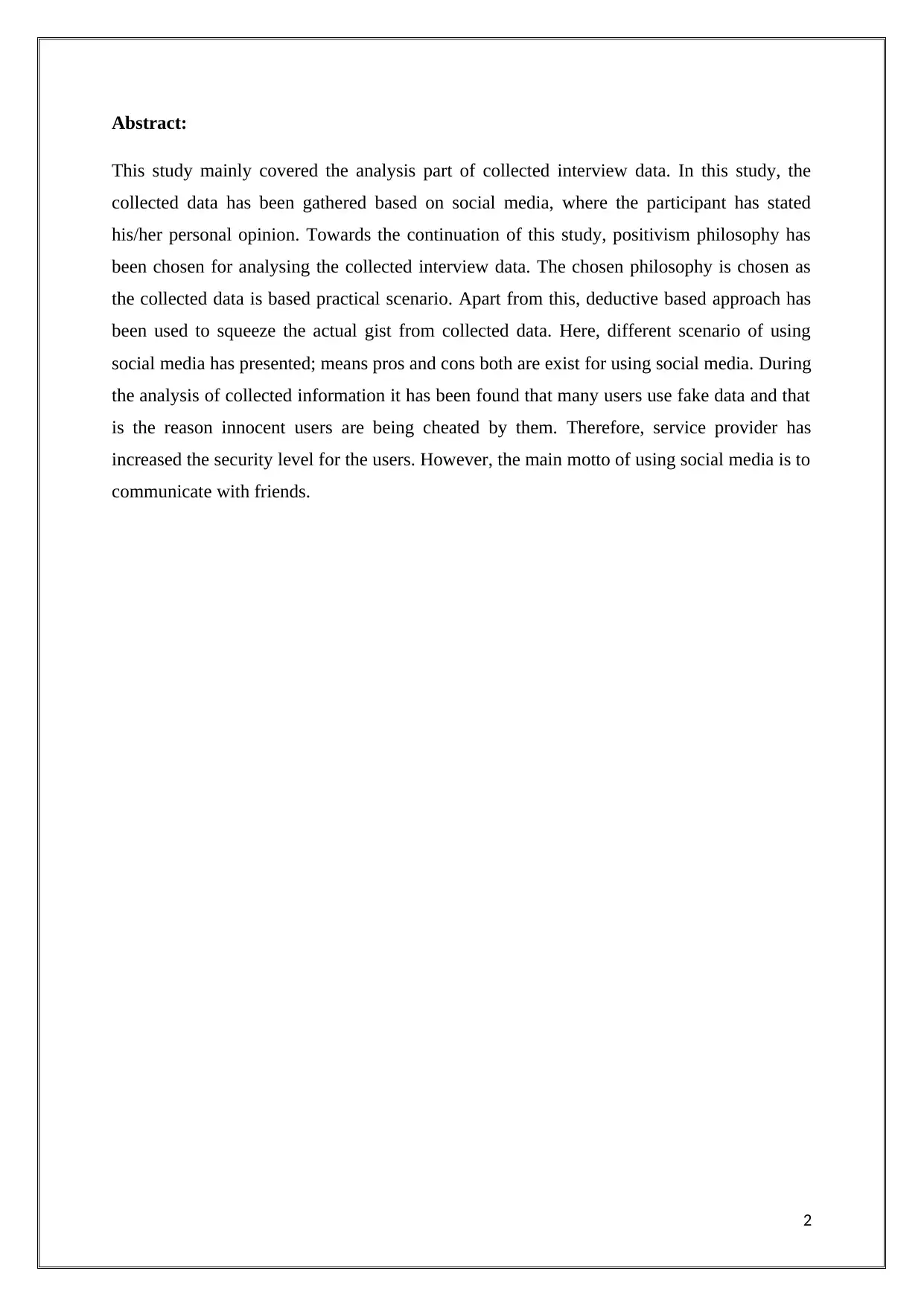
Abstract:
This study mainly covered the analysis part of collected interview data. In this study, the
collected data has been gathered based on social media, where the participant has stated
his/her personal opinion. Towards the continuation of this study, positivism philosophy has
been chosen for analysing the collected interview data. The chosen philosophy is chosen as
the collected data is based practical scenario. Apart from this, deductive based approach has
been used to squeeze the actual gist from collected data. Here, different scenario of using
social media has presented; means pros and cons both are exist for using social media. During
the analysis of collected information it has been found that many users use fake data and that
is the reason innocent users are being cheated by them. Therefore, service provider has
increased the security level for the users. However, the main motto of using social media is to
communicate with friends.
2
This study mainly covered the analysis part of collected interview data. In this study, the
collected data has been gathered based on social media, where the participant has stated
his/her personal opinion. Towards the continuation of this study, positivism philosophy has
been chosen for analysing the collected interview data. The chosen philosophy is chosen as
the collected data is based practical scenario. Apart from this, deductive based approach has
been used to squeeze the actual gist from collected data. Here, different scenario of using
social media has presented; means pros and cons both are exist for using social media. During
the analysis of collected information it has been found that many users use fake data and that
is the reason innocent users are being cheated by them. Therefore, service provider has
increased the security level for the users. However, the main motto of using social media is to
communicate with friends.
2
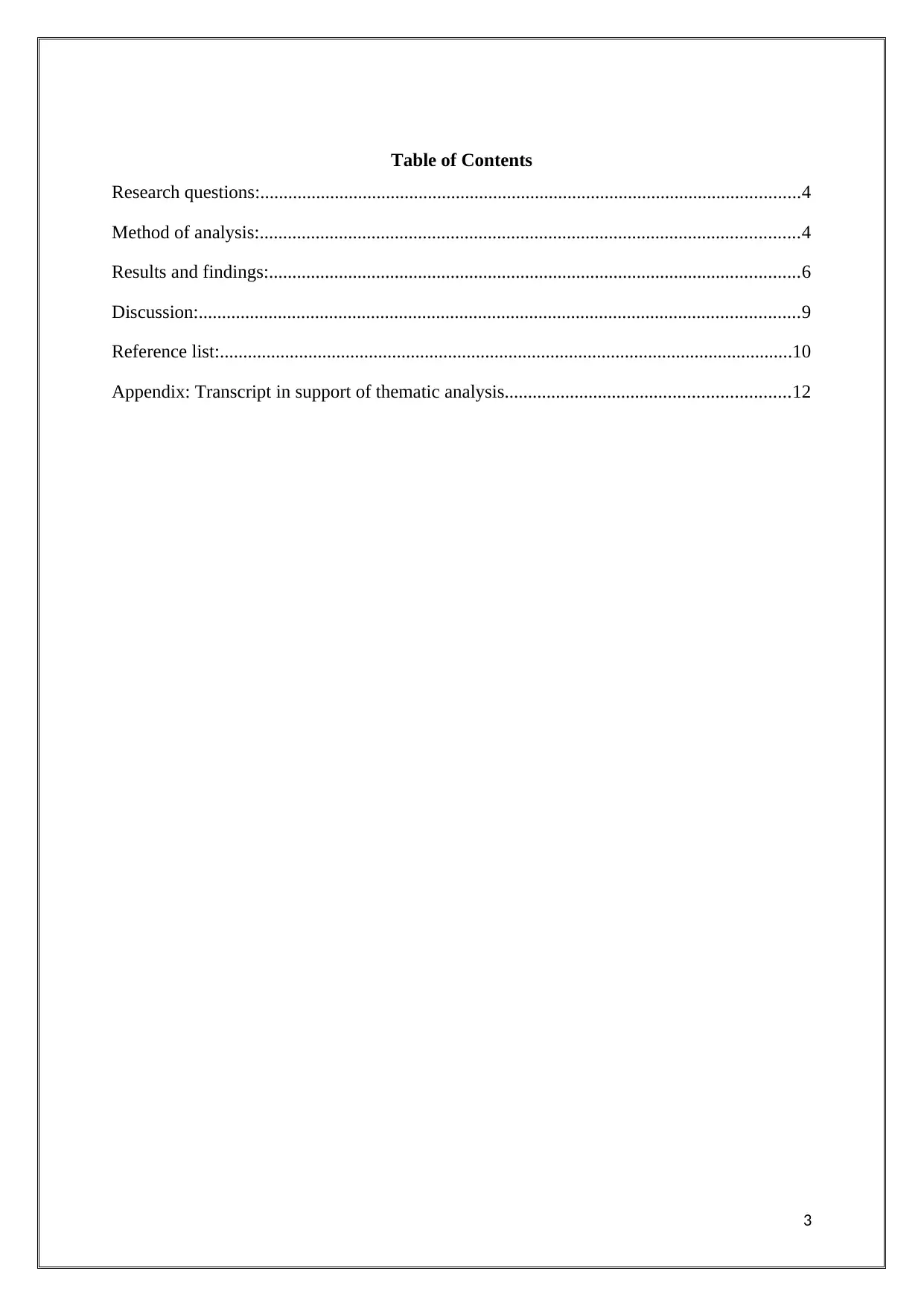
Table of Contents
Research questions:....................................................................................................................4
Method of analysis:....................................................................................................................4
Results and findings:..................................................................................................................6
Discussion:.................................................................................................................................9
Reference list:...........................................................................................................................10
Appendix: Transcript in support of thematic analysis.............................................................12
3
Research questions:....................................................................................................................4
Method of analysis:....................................................................................................................4
Results and findings:..................................................................................................................6
Discussion:.................................................................................................................................9
Reference list:...........................................................................................................................10
Appendix: Transcript in support of thematic analysis.............................................................12
3
⊘ This is a preview!⊘
Do you want full access?
Subscribe today to unlock all pages.

Trusted by 1+ million students worldwide
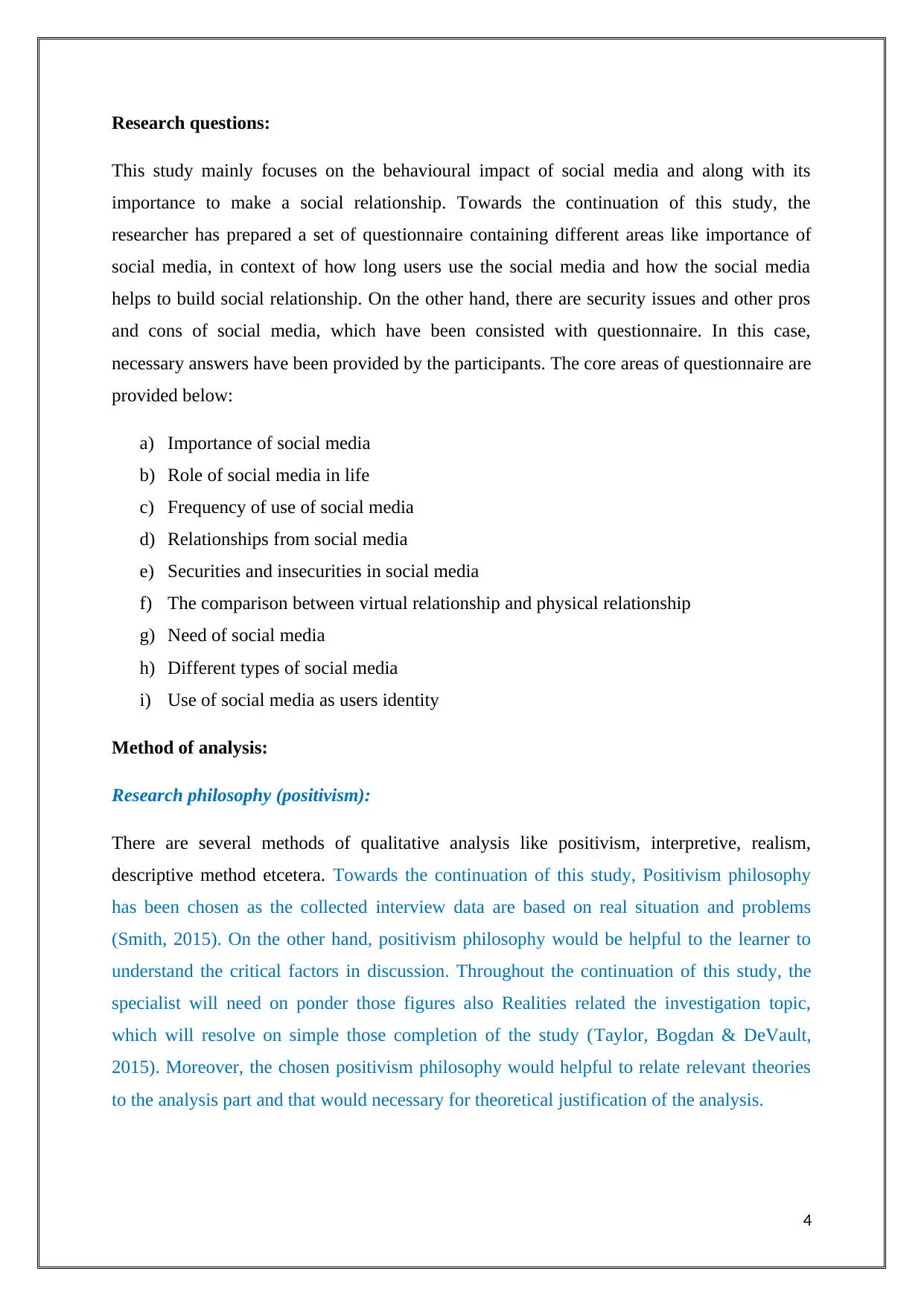
Research questions:
This study mainly focuses on the behavioural impact of social media and along with its
importance to make a social relationship. Towards the continuation of this study, the
researcher has prepared a set of questionnaire containing different areas like importance of
social media, in context of how long users use the social media and how the social media
helps to build social relationship. On the other hand, there are security issues and other pros
and cons of social media, which have been consisted with questionnaire. In this case,
necessary answers have been provided by the participants. The core areas of questionnaire are
provided below:
a) Importance of social media
b) Role of social media in life
c) Frequency of use of social media
d) Relationships from social media
e) Securities and insecurities in social media
f) The comparison between virtual relationship and physical relationship
g) Need of social media
h) Different types of social media
i) Use of social media as users identity
Method of analysis:
Research philosophy (positivism):
There are several methods of qualitative analysis like positivism, interpretive, realism,
descriptive method etcetera. Towards the continuation of this study, Positivism philosophy
has been chosen as the collected interview data are based on real situation and problems
(Smith, 2015). On the other hand, positivism philosophy would be helpful to the learner to
understand the critical factors in discussion. Throughout the continuation of this study, the
specialist will need on ponder those figures also Realities related the investigation topic,
which will resolve on simple those completion of the study (Taylor, Bogdan & DeVault,
2015). Moreover, the chosen positivism philosophy would helpful to relate relevant theories
to the analysis part and that would necessary for theoretical justification of the analysis.
4
This study mainly focuses on the behavioural impact of social media and along with its
importance to make a social relationship. Towards the continuation of this study, the
researcher has prepared a set of questionnaire containing different areas like importance of
social media, in context of how long users use the social media and how the social media
helps to build social relationship. On the other hand, there are security issues and other pros
and cons of social media, which have been consisted with questionnaire. In this case,
necessary answers have been provided by the participants. The core areas of questionnaire are
provided below:
a) Importance of social media
b) Role of social media in life
c) Frequency of use of social media
d) Relationships from social media
e) Securities and insecurities in social media
f) The comparison between virtual relationship and physical relationship
g) Need of social media
h) Different types of social media
i) Use of social media as users identity
Method of analysis:
Research philosophy (positivism):
There are several methods of qualitative analysis like positivism, interpretive, realism,
descriptive method etcetera. Towards the continuation of this study, Positivism philosophy
has been chosen as the collected interview data are based on real situation and problems
(Smith, 2015). On the other hand, positivism philosophy would be helpful to the learner to
understand the critical factors in discussion. Throughout the continuation of this study, the
specialist will need on ponder those figures also Realities related the investigation topic,
which will resolve on simple those completion of the study (Taylor, Bogdan & DeVault,
2015). Moreover, the chosen positivism philosophy would helpful to relate relevant theories
to the analysis part and that would necessary for theoretical justification of the analysis.
4
Paraphrase This Document
Need a fresh take? Get an instant paraphrase of this document with our AI Paraphraser
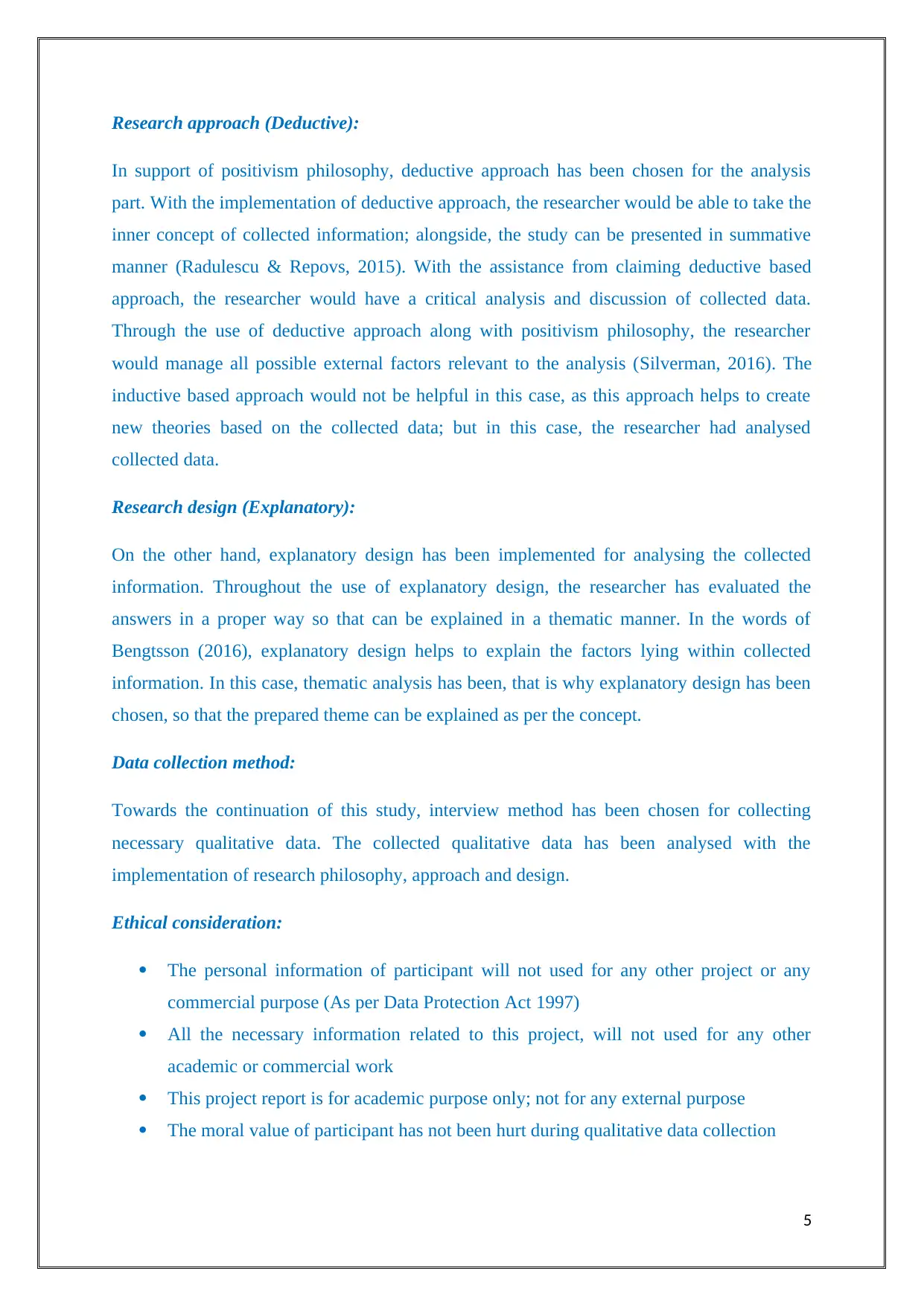
Research approach (Deductive):
In support of positivism philosophy, deductive approach has been chosen for the analysis
part. With the implementation of deductive approach, the researcher would be able to take the
inner concept of collected information; alongside, the study can be presented in summative
manner (Radulescu & Repovs, 2015). With the assistance from claiming deductive based
approach, the researcher would have a critical analysis and discussion of collected data.
Through the use of deductive approach along with positivism philosophy, the researcher
would manage all possible external factors relevant to the analysis (Silverman, 2016). The
inductive based approach would not be helpful in this case, as this approach helps to create
new theories based on the collected data; but in this case, the researcher had analysed
collected data.
Research design (Explanatory):
On the other hand, explanatory design has been implemented for analysing the collected
information. Throughout the use of explanatory design, the researcher has evaluated the
answers in a proper way so that can be explained in a thematic manner. In the words of
Bengtsson (2016), explanatory design helps to explain the factors lying within collected
information. In this case, thematic analysis has been, that is why explanatory design has been
chosen, so that the prepared theme can be explained as per the concept.
Data collection method:
Towards the continuation of this study, interview method has been chosen for collecting
necessary qualitative data. The collected qualitative data has been analysed with the
implementation of research philosophy, approach and design.
Ethical consideration:
The personal information of participant will not used for any other project or any
commercial purpose (As per Data Protection Act 1997)
All the necessary information related to this project, will not used for any other
academic or commercial work
This project report is for academic purpose only; not for any external purpose
The moral value of participant has not been hurt during qualitative data collection
5
In support of positivism philosophy, deductive approach has been chosen for the analysis
part. With the implementation of deductive approach, the researcher would be able to take the
inner concept of collected information; alongside, the study can be presented in summative
manner (Radulescu & Repovs, 2015). With the assistance from claiming deductive based
approach, the researcher would have a critical analysis and discussion of collected data.
Through the use of deductive approach along with positivism philosophy, the researcher
would manage all possible external factors relevant to the analysis (Silverman, 2016). The
inductive based approach would not be helpful in this case, as this approach helps to create
new theories based on the collected data; but in this case, the researcher had analysed
collected data.
Research design (Explanatory):
On the other hand, explanatory design has been implemented for analysing the collected
information. Throughout the use of explanatory design, the researcher has evaluated the
answers in a proper way so that can be explained in a thematic manner. In the words of
Bengtsson (2016), explanatory design helps to explain the factors lying within collected
information. In this case, thematic analysis has been, that is why explanatory design has been
chosen, so that the prepared theme can be explained as per the concept.
Data collection method:
Towards the continuation of this study, interview method has been chosen for collecting
necessary qualitative data. The collected qualitative data has been analysed with the
implementation of research philosophy, approach and design.
Ethical consideration:
The personal information of participant will not used for any other project or any
commercial purpose (As per Data Protection Act 1997)
All the necessary information related to this project, will not used for any other
academic or commercial work
This project report is for academic purpose only; not for any external purpose
The moral value of participant has not been hurt during qualitative data collection
5
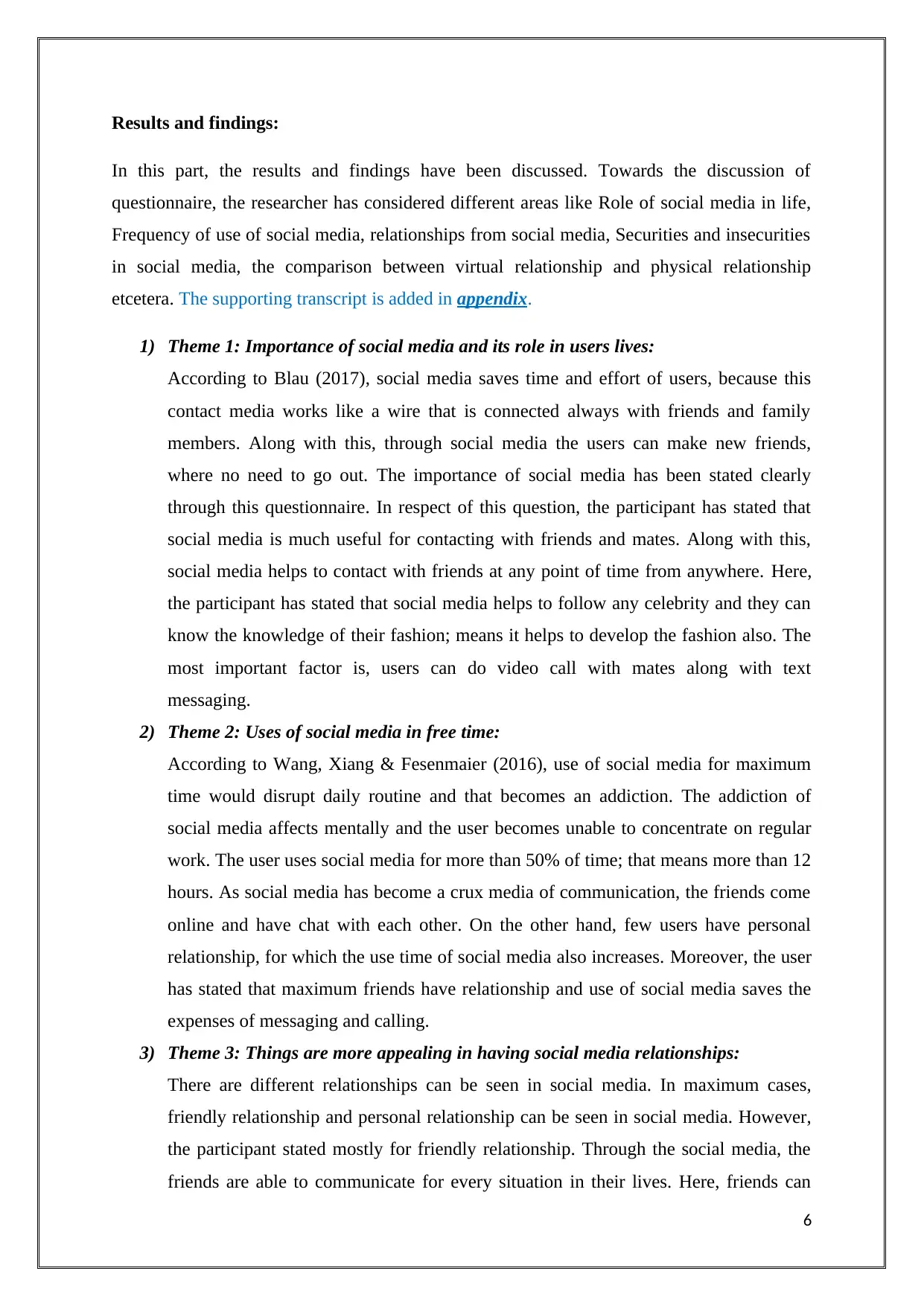
Results and findings:
In this part, the results and findings have been discussed. Towards the discussion of
questionnaire, the researcher has considered different areas like Role of social media in life,
Frequency of use of social media, relationships from social media, Securities and insecurities
in social media, the comparison between virtual relationship and physical relationship
etcetera. The supporting transcript is added in appendix.
1) Theme 1: Importance of social media and its role in users lives:
According to Blau (2017), social media saves time and effort of users, because this
contact media works like a wire that is connected always with friends and family
members. Along with this, through social media the users can make new friends,
where no need to go out. The importance of social media has been stated clearly
through this questionnaire. In respect of this question, the participant has stated that
social media is much useful for contacting with friends and mates. Along with this,
social media helps to contact with friends at any point of time from anywhere. Here,
the participant has stated that social media helps to follow any celebrity and they can
know the knowledge of their fashion; means it helps to develop the fashion also. The
most important factor is, users can do video call with mates along with text
messaging.
2) Theme 2: Uses of social media in free time:
According to Wang, Xiang & Fesenmaier (2016), use of social media for maximum
time would disrupt daily routine and that becomes an addiction. The addiction of
social media affects mentally and the user becomes unable to concentrate on regular
work. The user uses social media for more than 50% of time; that means more than 12
hours. As social media has become a crux media of communication, the friends come
online and have chat with each other. On the other hand, few users have personal
relationship, for which the use time of social media also increases. Moreover, the user
has stated that maximum friends have relationship and use of social media saves the
expenses of messaging and calling.
3) Theme 3: Things are more appealing in having social media relationships:
There are different relationships can be seen in social media. In maximum cases,
friendly relationship and personal relationship can be seen in social media. However,
the participant stated mostly for friendly relationship. Through the social media, the
friends are able to communicate for every situation in their lives. Here, friends can
6
In this part, the results and findings have been discussed. Towards the discussion of
questionnaire, the researcher has considered different areas like Role of social media in life,
Frequency of use of social media, relationships from social media, Securities and insecurities
in social media, the comparison between virtual relationship and physical relationship
etcetera. The supporting transcript is added in appendix.
1) Theme 1: Importance of social media and its role in users lives:
According to Blau (2017), social media saves time and effort of users, because this
contact media works like a wire that is connected always with friends and family
members. Along with this, through social media the users can make new friends,
where no need to go out. The importance of social media has been stated clearly
through this questionnaire. In respect of this question, the participant has stated that
social media is much useful for contacting with friends and mates. Along with this,
social media helps to contact with friends at any point of time from anywhere. Here,
the participant has stated that social media helps to follow any celebrity and they can
know the knowledge of their fashion; means it helps to develop the fashion also. The
most important factor is, users can do video call with mates along with text
messaging.
2) Theme 2: Uses of social media in free time:
According to Wang, Xiang & Fesenmaier (2016), use of social media for maximum
time would disrupt daily routine and that becomes an addiction. The addiction of
social media affects mentally and the user becomes unable to concentrate on regular
work. The user uses social media for more than 50% of time; that means more than 12
hours. As social media has become a crux media of communication, the friends come
online and have chat with each other. On the other hand, few users have personal
relationship, for which the use time of social media also increases. Moreover, the user
has stated that maximum friends have relationship and use of social media saves the
expenses of messaging and calling.
3) Theme 3: Things are more appealing in having social media relationships:
There are different relationships can be seen in social media. In maximum cases,
friendly relationship and personal relationship can be seen in social media. However,
the participant stated mostly for friendly relationship. Through the social media, the
friends are able to communicate for every situation in their lives. Here, friends can
6
⊘ This is a preview!⊘
Do you want full access?
Subscribe today to unlock all pages.

Trusted by 1+ million students worldwide
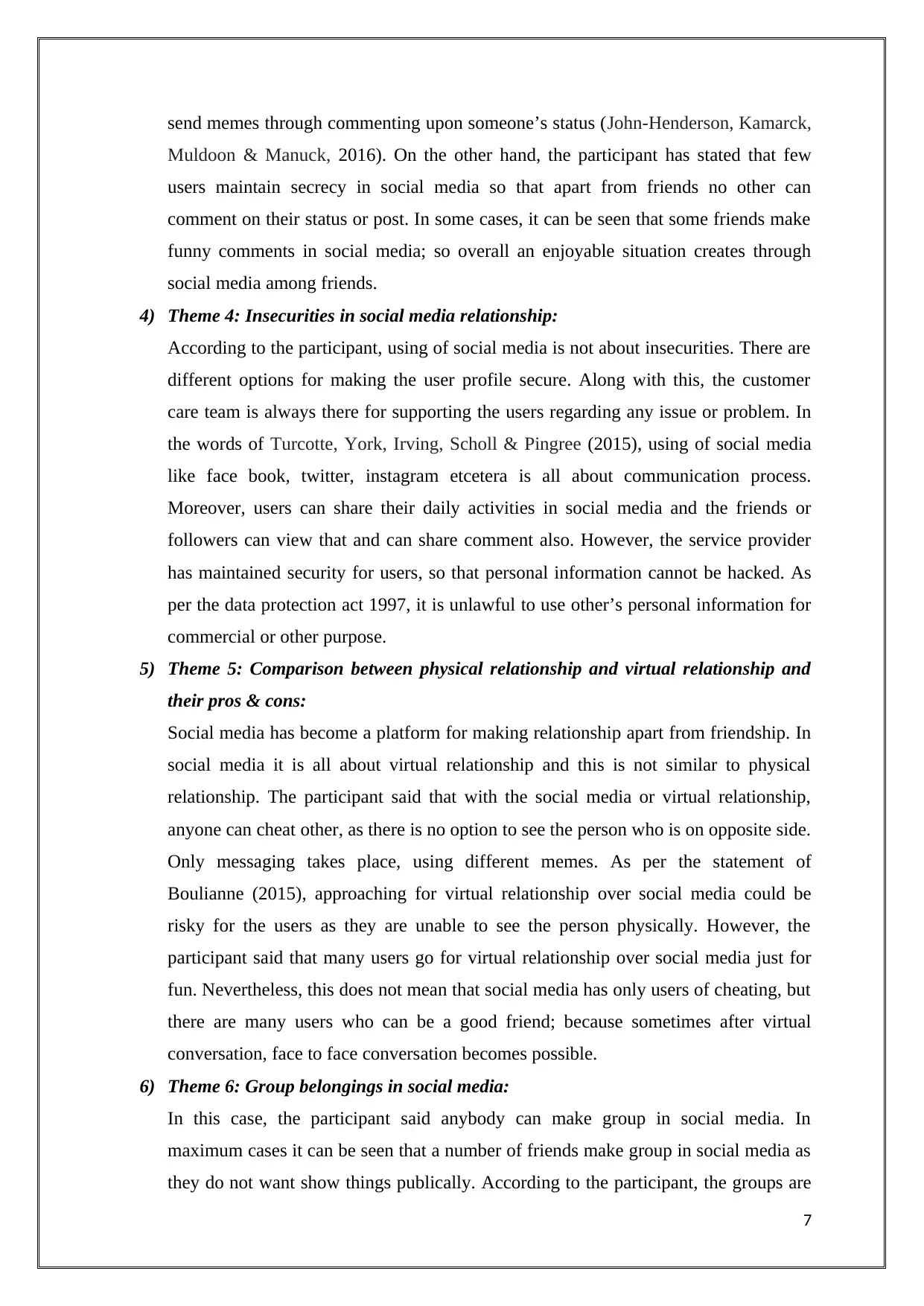
send memes through commenting upon someone’s status (John-Henderson, Kamarck,
Muldoon & Manuck, 2016). On the other hand, the participant has stated that few
users maintain secrecy in social media so that apart from friends no other can
comment on their status or post. In some cases, it can be seen that some friends make
funny comments in social media; so overall an enjoyable situation creates through
social media among friends.
4) Theme 4: Insecurities in social media relationship:
According to the participant, using of social media is not about insecurities. There are
different options for making the user profile secure. Along with this, the customer
care team is always there for supporting the users regarding any issue or problem. In
the words of Turcotte, York, Irving, Scholl & Pingree (2015), using of social media
like face book, twitter, instagram etcetera is all about communication process.
Moreover, users can share their daily activities in social media and the friends or
followers can view that and can share comment also. However, the service provider
has maintained security for users, so that personal information cannot be hacked. As
per the data protection act 1997, it is unlawful to use other’s personal information for
commercial or other purpose.
5) Theme 5: Comparison between physical relationship and virtual relationship and
their pros & cons:
Social media has become a platform for making relationship apart from friendship. In
social media it is all about virtual relationship and this is not similar to physical
relationship. The participant said that with the social media or virtual relationship,
anyone can cheat other, as there is no option to see the person who is on opposite side.
Only messaging takes place, using different memes. As per the statement of
Boulianne (2015), approaching for virtual relationship over social media could be
risky for the users as they are unable to see the person physically. However, the
participant said that many users go for virtual relationship over social media just for
fun. Nevertheless, this does not mean that social media has only users of cheating, but
there are many users who can be a good friend; because sometimes after virtual
conversation, face to face conversation becomes possible.
6) Theme 6: Group belongings in social media:
In this case, the participant said anybody can make group in social media. In
maximum cases it can be seen that a number of friends make group in social media as
they do not want show things publically. According to the participant, the groups are
7
Muldoon & Manuck, 2016). On the other hand, the participant has stated that few
users maintain secrecy in social media so that apart from friends no other can
comment on their status or post. In some cases, it can be seen that some friends make
funny comments in social media; so overall an enjoyable situation creates through
social media among friends.
4) Theme 4: Insecurities in social media relationship:
According to the participant, using of social media is not about insecurities. There are
different options for making the user profile secure. Along with this, the customer
care team is always there for supporting the users regarding any issue or problem. In
the words of Turcotte, York, Irving, Scholl & Pingree (2015), using of social media
like face book, twitter, instagram etcetera is all about communication process.
Moreover, users can share their daily activities in social media and the friends or
followers can view that and can share comment also. However, the service provider
has maintained security for users, so that personal information cannot be hacked. As
per the data protection act 1997, it is unlawful to use other’s personal information for
commercial or other purpose.
5) Theme 5: Comparison between physical relationship and virtual relationship and
their pros & cons:
Social media has become a platform for making relationship apart from friendship. In
social media it is all about virtual relationship and this is not similar to physical
relationship. The participant said that with the social media or virtual relationship,
anyone can cheat other, as there is no option to see the person who is on opposite side.
Only messaging takes place, using different memes. As per the statement of
Boulianne (2015), approaching for virtual relationship over social media could be
risky for the users as they are unable to see the person physically. However, the
participant said that many users go for virtual relationship over social media just for
fun. Nevertheless, this does not mean that social media has only users of cheating, but
there are many users who can be a good friend; because sometimes after virtual
conversation, face to face conversation becomes possible.
6) Theme 6: Group belongings in social media:
In this case, the participant said anybody can make group in social media. In
maximum cases it can be seen that a number of friends make group in social media as
they do not want show things publically. According to the participant, the groups are
7
Paraphrase This Document
Need a fresh take? Get an instant paraphrase of this document with our AI Paraphraser
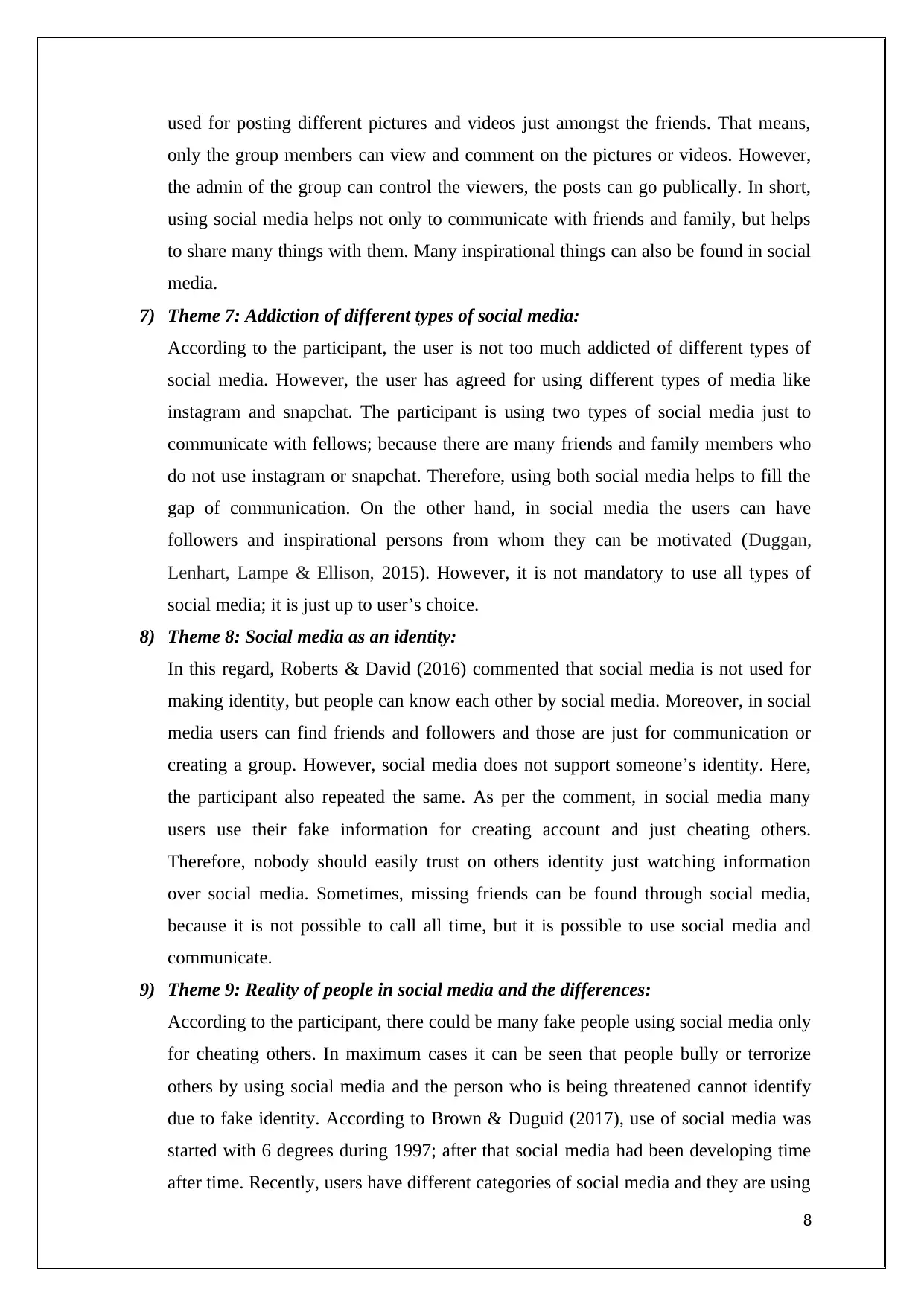
used for posting different pictures and videos just amongst the friends. That means,
only the group members can view and comment on the pictures or videos. However,
the admin of the group can control the viewers, the posts can go publically. In short,
using social media helps not only to communicate with friends and family, but helps
to share many things with them. Many inspirational things can also be found in social
media.
7) Theme 7: Addiction of different types of social media:
According to the participant, the user is not too much addicted of different types of
social media. However, the user has agreed for using different types of media like
instagram and snapchat. The participant is using two types of social media just to
communicate with fellows; because there are many friends and family members who
do not use instagram or snapchat. Therefore, using both social media helps to fill the
gap of communication. On the other hand, in social media the users can have
followers and inspirational persons from whom they can be motivated (Duggan,
Lenhart, Lampe & Ellison, 2015). However, it is not mandatory to use all types of
social media; it is just up to user’s choice.
8) Theme 8: Social media as an identity:
In this regard, Roberts & David (2016) commented that social media is not used for
making identity, but people can know each other by social media. Moreover, in social
media users can find friends and followers and those are just for communication or
creating a group. However, social media does not support someone’s identity. Here,
the participant also repeated the same. As per the comment, in social media many
users use their fake information for creating account and just cheating others.
Therefore, nobody should easily trust on others identity just watching information
over social media. Sometimes, missing friends can be found through social media,
because it is not possible to call all time, but it is possible to use social media and
communicate.
9) Theme 9: Reality of people in social media and the differences:
According to the participant, there could be many fake people using social media only
for cheating others. In maximum cases it can be seen that people bully or terrorize
others by using social media and the person who is being threatened cannot identify
due to fake identity. According to Brown & Duguid (2017), use of social media was
started with 6 degrees during 1997; after that social media had been developing time
after time. Recently, users have different categories of social media and they are using
8
only the group members can view and comment on the pictures or videos. However,
the admin of the group can control the viewers, the posts can go publically. In short,
using social media helps not only to communicate with friends and family, but helps
to share many things with them. Many inspirational things can also be found in social
media.
7) Theme 7: Addiction of different types of social media:
According to the participant, the user is not too much addicted of different types of
social media. However, the user has agreed for using different types of media like
instagram and snapchat. The participant is using two types of social media just to
communicate with fellows; because there are many friends and family members who
do not use instagram or snapchat. Therefore, using both social media helps to fill the
gap of communication. On the other hand, in social media the users can have
followers and inspirational persons from whom they can be motivated (Duggan,
Lenhart, Lampe & Ellison, 2015). However, it is not mandatory to use all types of
social media; it is just up to user’s choice.
8) Theme 8: Social media as an identity:
In this regard, Roberts & David (2016) commented that social media is not used for
making identity, but people can know each other by social media. Moreover, in social
media users can find friends and followers and those are just for communication or
creating a group. However, social media does not support someone’s identity. Here,
the participant also repeated the same. As per the comment, in social media many
users use their fake information for creating account and just cheating others.
Therefore, nobody should easily trust on others identity just watching information
over social media. Sometimes, missing friends can be found through social media,
because it is not possible to call all time, but it is possible to use social media and
communicate.
9) Theme 9: Reality of people in social media and the differences:
According to the participant, there could be many fake people using social media only
for cheating others. In maximum cases it can be seen that people bully or terrorize
others by using social media and the person who is being threatened cannot identify
due to fake identity. According to Brown & Duguid (2017), use of social media was
started with 6 degrees during 1997; after that social media had been developing time
after time. Recently, users have different categories of social media and they are using
8
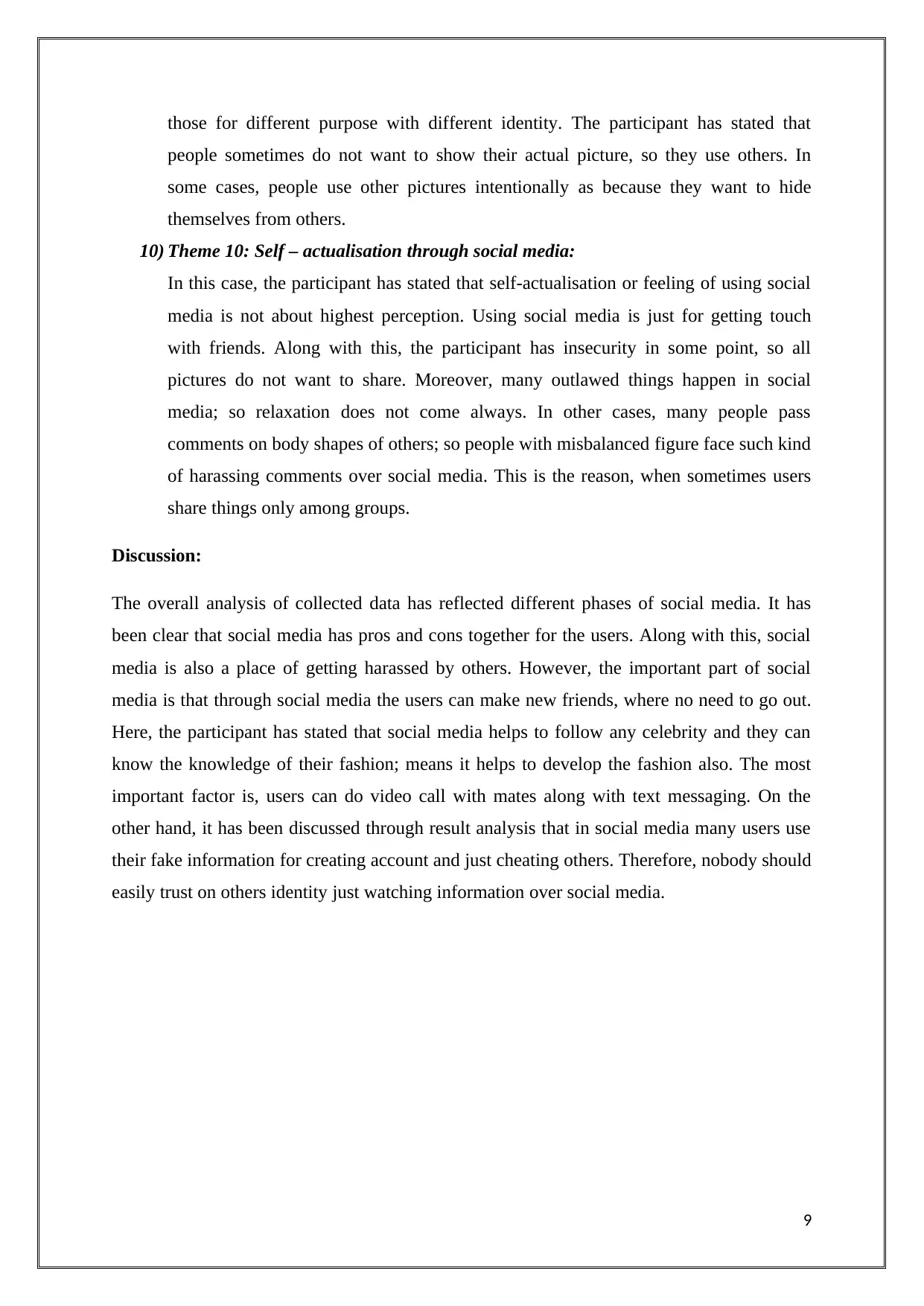
those for different purpose with different identity. The participant has stated that
people sometimes do not want to show their actual picture, so they use others. In
some cases, people use other pictures intentionally as because they want to hide
themselves from others.
10) Theme 10: Self – actualisation through social media:
In this case, the participant has stated that self-actualisation or feeling of using social
media is not about highest perception. Using social media is just for getting touch
with friends. Along with this, the participant has insecurity in some point, so all
pictures do not want to share. Moreover, many outlawed things happen in social
media; so relaxation does not come always. In other cases, many people pass
comments on body shapes of others; so people with misbalanced figure face such kind
of harassing comments over social media. This is the reason, when sometimes users
share things only among groups.
Discussion:
The overall analysis of collected data has reflected different phases of social media. It has
been clear that social media has pros and cons together for the users. Along with this, social
media is also a place of getting harassed by others. However, the important part of social
media is that through social media the users can make new friends, where no need to go out.
Here, the participant has stated that social media helps to follow any celebrity and they can
know the knowledge of their fashion; means it helps to develop the fashion also. The most
important factor is, users can do video call with mates along with text messaging. On the
other hand, it has been discussed through result analysis that in social media many users use
their fake information for creating account and just cheating others. Therefore, nobody should
easily trust on others identity just watching information over social media.
9
people sometimes do not want to show their actual picture, so they use others. In
some cases, people use other pictures intentionally as because they want to hide
themselves from others.
10) Theme 10: Self – actualisation through social media:
In this case, the participant has stated that self-actualisation or feeling of using social
media is not about highest perception. Using social media is just for getting touch
with friends. Along with this, the participant has insecurity in some point, so all
pictures do not want to share. Moreover, many outlawed things happen in social
media; so relaxation does not come always. In other cases, many people pass
comments on body shapes of others; so people with misbalanced figure face such kind
of harassing comments over social media. This is the reason, when sometimes users
share things only among groups.
Discussion:
The overall analysis of collected data has reflected different phases of social media. It has
been clear that social media has pros and cons together for the users. Along with this, social
media is also a place of getting harassed by others. However, the important part of social
media is that through social media the users can make new friends, where no need to go out.
Here, the participant has stated that social media helps to follow any celebrity and they can
know the knowledge of their fashion; means it helps to develop the fashion also. The most
important factor is, users can do video call with mates along with text messaging. On the
other hand, it has been discussed through result analysis that in social media many users use
their fake information for creating account and just cheating others. Therefore, nobody should
easily trust on others identity just watching information over social media.
9
⊘ This is a preview!⊘
Do you want full access?
Subscribe today to unlock all pages.

Trusted by 1+ million students worldwide
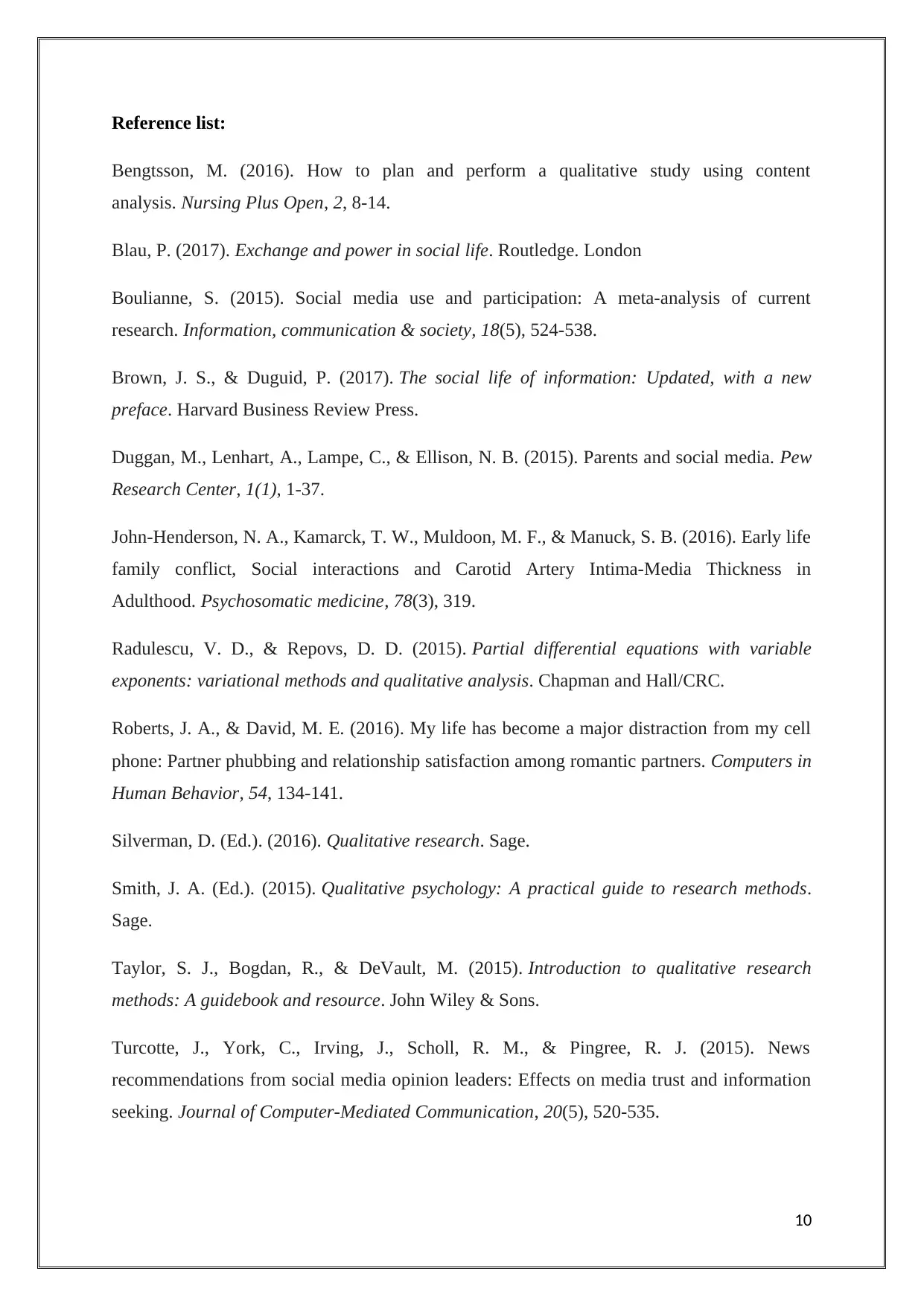
Reference list:
Bengtsson, M. (2016). How to plan and perform a qualitative study using content
analysis. Nursing Plus Open, 2, 8-14.
Blau, P. (2017). Exchange and power in social life. Routledge. London
Boulianne, S. (2015). Social media use and participation: A meta-analysis of current
research. Information, communication & society, 18(5), 524-538.
Brown, J. S., & Duguid, P. (2017). The social life of information: Updated, with a new
preface. Harvard Business Review Press.
Duggan, M., Lenhart, A., Lampe, C., & Ellison, N. B. (2015). Parents and social media. Pew
Research Center, 1(1), 1-37.
John-Henderson, N. A., Kamarck, T. W., Muldoon, M. F., & Manuck, S. B. (2016). Early life
family conflict, Social interactions and Carotid Artery Intima-Media Thickness in
Adulthood. Psychosomatic medicine, 78(3), 319.
Radulescu, V. D., & Repovs, D. D. (2015). Partial differential equations with variable
exponents: variational methods and qualitative analysis. Chapman and Hall/CRC.
Roberts, J. A., & David, M. E. (2016). My life has become a major distraction from my cell
phone: Partner phubbing and relationship satisfaction among romantic partners. Computers in
Human Behavior, 54, 134-141.
Silverman, D. (Ed.). (2016). Qualitative research. Sage.
Smith, J. A. (Ed.). (2015). Qualitative psychology: A practical guide to research methods.
Sage.
Taylor, S. J., Bogdan, R., & DeVault, M. (2015). Introduction to qualitative research
methods: A guidebook and resource. John Wiley & Sons.
Turcotte, J., York, C., Irving, J., Scholl, R. M., & Pingree, R. J. (2015). News
recommendations from social media opinion leaders: Effects on media trust and information
seeking. Journal of Computer-Mediated Communication, 20(5), 520-535.
10
Bengtsson, M. (2016). How to plan and perform a qualitative study using content
analysis. Nursing Plus Open, 2, 8-14.
Blau, P. (2017). Exchange and power in social life. Routledge. London
Boulianne, S. (2015). Social media use and participation: A meta-analysis of current
research. Information, communication & society, 18(5), 524-538.
Brown, J. S., & Duguid, P. (2017). The social life of information: Updated, with a new
preface. Harvard Business Review Press.
Duggan, M., Lenhart, A., Lampe, C., & Ellison, N. B. (2015). Parents and social media. Pew
Research Center, 1(1), 1-37.
John-Henderson, N. A., Kamarck, T. W., Muldoon, M. F., & Manuck, S. B. (2016). Early life
family conflict, Social interactions and Carotid Artery Intima-Media Thickness in
Adulthood. Psychosomatic medicine, 78(3), 319.
Radulescu, V. D., & Repovs, D. D. (2015). Partial differential equations with variable
exponents: variational methods and qualitative analysis. Chapman and Hall/CRC.
Roberts, J. A., & David, M. E. (2016). My life has become a major distraction from my cell
phone: Partner phubbing and relationship satisfaction among romantic partners. Computers in
Human Behavior, 54, 134-141.
Silverman, D. (Ed.). (2016). Qualitative research. Sage.
Smith, J. A. (Ed.). (2015). Qualitative psychology: A practical guide to research methods.
Sage.
Taylor, S. J., Bogdan, R., & DeVault, M. (2015). Introduction to qualitative research
methods: A guidebook and resource. John Wiley & Sons.
Turcotte, J., York, C., Irving, J., Scholl, R. M., & Pingree, R. J. (2015). News
recommendations from social media opinion leaders: Effects on media trust and information
seeking. Journal of Computer-Mediated Communication, 20(5), 520-535.
10
Paraphrase This Document
Need a fresh take? Get an instant paraphrase of this document with our AI Paraphraser
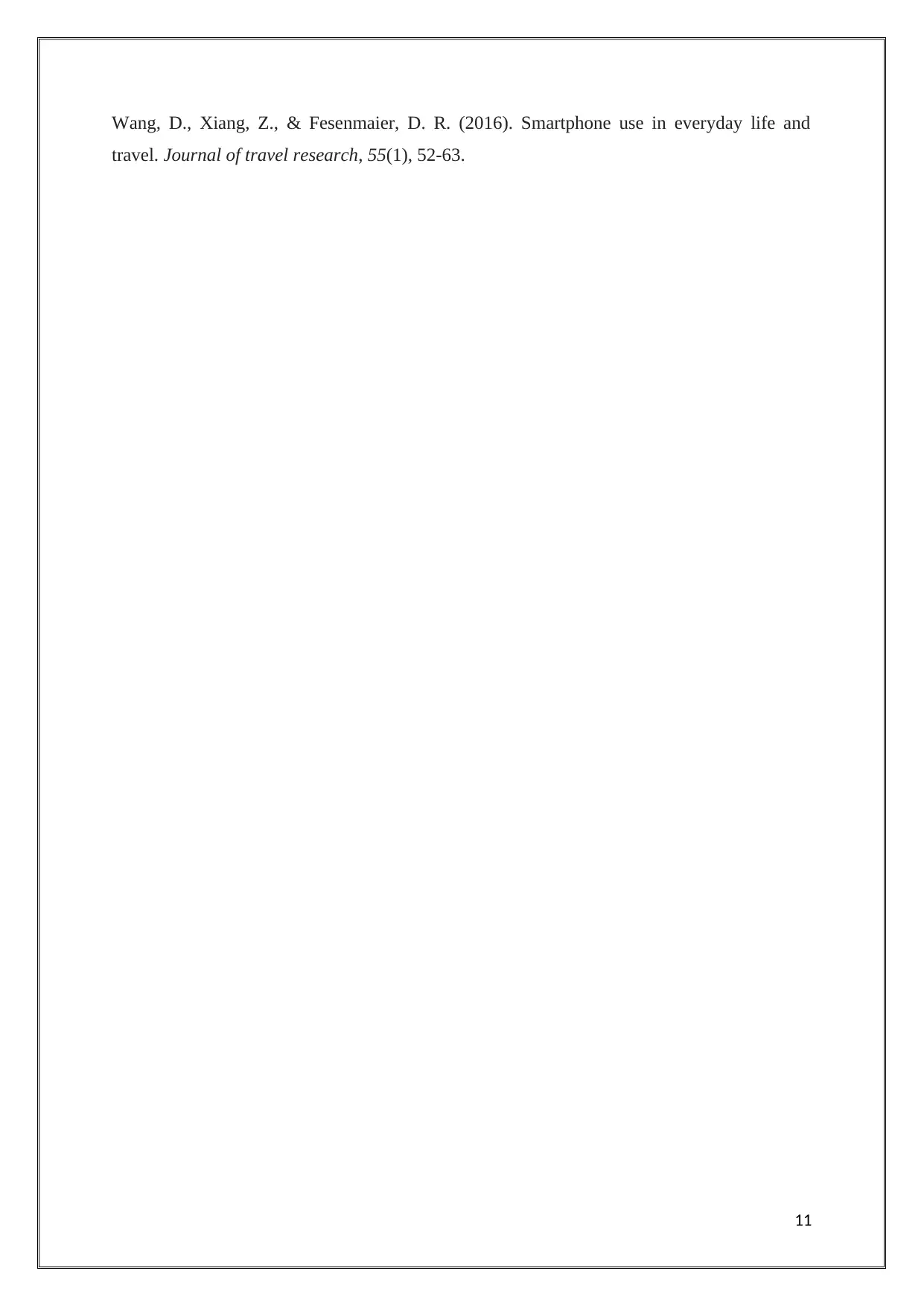
Wang, D., Xiang, Z., & Fesenmaier, D. R. (2016). Smartphone use in everyday life and
travel. Journal of travel research, 55(1), 52-63.
11
travel. Journal of travel research, 55(1), 52-63.
11
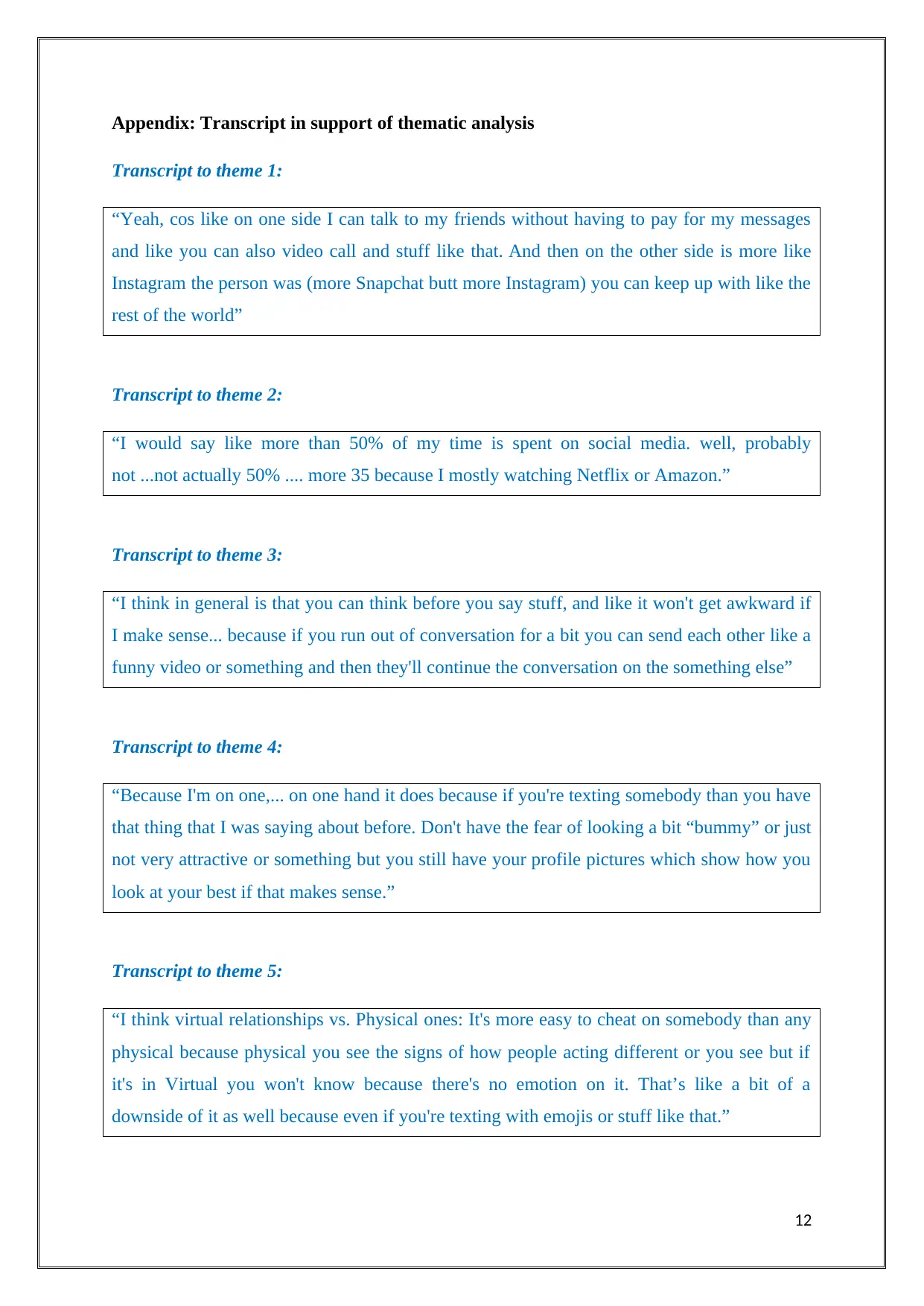
Appendix: Transcript in support of thematic analysis
Transcript to theme 1:
“Yeah, cos like on one side I can talk to my friends without having to pay for my messages
and like you can also video call and stuff like that. And then on the other side is more like
Instagram the person was (more Snapchat butt more Instagram) you can keep up with like the
rest of the world”
Transcript to theme 2:
“I would say like more than 50% of my time is spent on social media. well, probably
not ...not actually 50% .... more 35 because I mostly watching Netflix or Amazon.”
Transcript to theme 3:
“I think in general is that you can think before you say stuff, and like it won't get awkward if
I make sense... because if you run out of conversation for a bit you can send each other like a
funny video or something and then they'll continue the conversation on the something else”
Transcript to theme 4:
“Because I'm on one,... on one hand it does because if you're texting somebody than you have
that thing that I was saying about before. Don't have the fear of looking a bit “bummy” or just
not very attractive or something but you still have your profile pictures which show how you
look at your best if that makes sense.”
Transcript to theme 5:
“I think virtual relationships vs. Physical ones: It's more easy to cheat on somebody than any
physical because physical you see the signs of how people acting different or you see but if
it's in Virtual you won't know because there's no emotion on it. That’s like a bit of a
downside of it as well because even if you're texting with emojis or stuff like that.”
12
Transcript to theme 1:
“Yeah, cos like on one side I can talk to my friends without having to pay for my messages
and like you can also video call and stuff like that. And then on the other side is more like
Instagram the person was (more Snapchat butt more Instagram) you can keep up with like the
rest of the world”
Transcript to theme 2:
“I would say like more than 50% of my time is spent on social media. well, probably
not ...not actually 50% .... more 35 because I mostly watching Netflix or Amazon.”
Transcript to theme 3:
“I think in general is that you can think before you say stuff, and like it won't get awkward if
I make sense... because if you run out of conversation for a bit you can send each other like a
funny video or something and then they'll continue the conversation on the something else”
Transcript to theme 4:
“Because I'm on one,... on one hand it does because if you're texting somebody than you have
that thing that I was saying about before. Don't have the fear of looking a bit “bummy” or just
not very attractive or something but you still have your profile pictures which show how you
look at your best if that makes sense.”
Transcript to theme 5:
“I think virtual relationships vs. Physical ones: It's more easy to cheat on somebody than any
physical because physical you see the signs of how people acting different or you see but if
it's in Virtual you won't know because there's no emotion on it. That’s like a bit of a
downside of it as well because even if you're texting with emojis or stuff like that.”
12
⊘ This is a preview!⊘
Do you want full access?
Subscribe today to unlock all pages.

Trusted by 1+ million students worldwide
1 out of 13
Related Documents
Your All-in-One AI-Powered Toolkit for Academic Success.
+13062052269
info@desklib.com
Available 24*7 on WhatsApp / Email
![[object Object]](/_next/static/media/star-bottom.7253800d.svg)
Unlock your academic potential
Copyright © 2020–2025 A2Z Services. All Rights Reserved. Developed and managed by ZUCOL.





